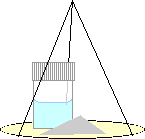![]()
![]()
As Noted in Experiment 1-3, volume sometimes changes when no material enters or leaves the system. This happens when a substance changes state. When liquid water boils to the gas called steam inside a closed balloon, the volume increases greatly although no substance enters the balloon.&nsp; When the steam is allowed to cool, the balloon goes back to its previous volume even though no substance exits the balloon.
When liquid water freezes it expands its volume. If this happens in a completely full container, the container often is ruptured. This beverages containers usually are capped with some room remaining inside for expansion. We often add antifreeze to water cooled engines so the engines are not destroyed by the expansion that would occur upon water's freezing.
Even if a change of state does not occur, substances still expand volume when warmed and shrink when cooled. That is why concrete structures such as sidewalks, highway bridges, and large buildings are built with expansion joints so expansion and contraction due to temperature changes don't destroy the structure. This feature was used by Daniel Gabriel Fahrenheit (born 1686 in Gdansk, died 1736 in the Hague), a physicist and early instrument maker, to construct devices that used differences in expansion to measure temperature. Using a very narrow container neck, his devices amplified the change in the meniscus of the liquid which had a greater rate of expansion than its container. He used reproducible warm (body) and cold (ice-salt) baths as standards to place high and low marks on his thermometers. He then divided the distance between the two marks much as we did with the rider on your balance.
While not as easy to observe, volume also changes when one substance dissolves in another.
But scientists and merchants need a reliable way to measure the quantity of substances. To be reliable, a procedure measuring a property must reproducibly give the same measure for the same material even it the circumstances change. The variations in volume due to change in state, dissolving, and temperature changes suggest that volume is far from ideal as a reliable measure.

We are searching for a reliable method to measure materials. We know that volume changes when one material dissolves in another. This experiment investigates if mass also is changed by dissolving.
Considering the sensitivity and limits of your balance, find a small container with tight lid, water, and some table salt that can be massed with your balance. Dissolve the salt in the water, then determine the mass after dissolving. Does the mass change significantly?
Rarely do scientists come to an important conclusion based on a single trial. No measurement is perfect. Every measurement contains small errors due to the limitations of the equipment as well as variations caused by the procedure. To reduce such experimental errors scientists often do the same experiment a number of times then use the average of all measurements that seem consistent and where no errors are apparent. Of course if a leak or spill occurs, those results are not included. Repeat this experiment a number of times and base your conclusion about the reliability of mass based on the average change.
Make a histogram of your results to visualize any pattern in your measurements.
Record in your science journal the mass measurements, first in table format, then by constructing a histogram. Write a Formal Report if you need to earn credit.
Repeat the experiment with other soluble materials such as table sugar, baking soda, or rubbing alcohol.
![]()
to Experiment 2-2
to Physical Science menu
to site menu